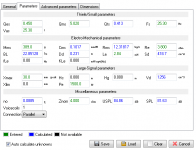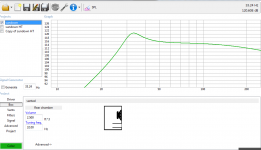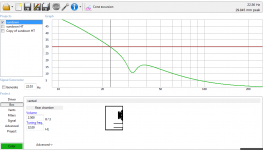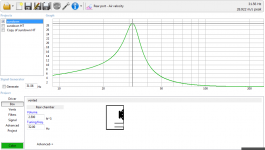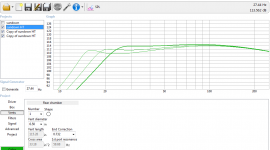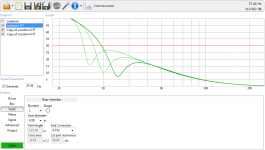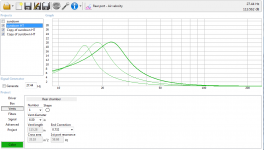Ive built alot of enclosures for a vehicle and usually tune to the typical low 30's but this will be my first one for in home use. What are typical ported home subwoofers tuned too? Im under the impression they are tuned lower. If it could help answer what tuning I should run, I will be using a sundown x-12 v1.
Could you possibly recommend some free software? I never just picked a tuning and threw a random driver in any size box. I always used the manufacturers recommended tuning, port area, and box size. I assumed the company did the calculating and gave numbers that would give the best response and sound. Well generally speaking, I know each vehicle is different.
getting started
This is my nooby method, using one website and one piece of software. Take all advice with a grain of salt, and hopefully there will be corrections from some of the more knowledgeable people around here
Software: WinISD
WinISD - Linearteam
Supposedly the older version is more accurate than the newest version; I haven't compared them. My screenshots and files are from the .7x 'non-pro' newest version. Pro=old and is free apparently? I really don't get what the history is there haha. Either way there are far more powerful modellers out there (Hornresp for example), but this one is IMO far easier to get started with.
Other tutorials here, for the old version:
Guide: Using WinISD
WinISD
Anyway your driver specs here:
X SERIES (Discontinued) – Sundown Audio
I used the dual 2 ohm, and the specs given are with both wired in series.
Took the power rating and xmax from the v.2 as they weren't listed on the above page. (the 4 inch peak to peak referred to on that page, ie ~52mm one way, is more an xmech rating, which is the point of damage. We want xmax, which is (supposed to be) where it starts sounding bad.)
Sundown Audio X12 - Down4soundShop
We can take a look at the recommended box size of 2.5ft3 tuned to 32hz. I set 'signal' to 1500watts, and turned on 'simulate voice coil inductance' under advanced to help with accuracy. The native response (outside of a car: to be specific, WinISD assumes flat on the ground with no walls nearby, aka 2pi space. Some simulators can change this as a parameter) has a large peak at 33hz. The excursion looks fine. It will sound great for all normal music, and stays under the damage range all the way down to 10hz. Since they gave a recommended port area we can also check vent speed, which is a little high but not absurd; they let it go up to 30m/s (assuming 1500watts) whereas most people here steer for under 17-20m/s as a broad target to avoid audible chuffing.
I modelled three possible home theater tunings. Generally for home theater we want a smooth 2pi response down to 30hz or so, for in-room response to 20hz or below (room gain should kick in below around 30hz, so it can roll off under there and still sound flat to more like 20hz, but you don't want any giant peaks or dips above there, as a general goal). All three have a problem which I will get to in a minute.
1.18ft3 25hz
1.74ft3 20hz
3.00ft3 16hz
Excursion is fine though movies sometimes have content under 10hz, so some high pass filtering would be nice if run at the full 1500w. They have lovely SPL. 25hz is the flattest; the lower tunings won't flatten out no matter how large you make the box. These boxes are tiny, because this is a car audio driver made to work in a tiny box with high power (low VAS, I think?). So the problem is, when you go to vent it, you have to keep increasing the vent area to get the air velocity down. As you do that, the vent gets longer. All three of these boxes would require giant, 8+ foot long ports. Which would create problematic resonances inside the frequency range you are trying to produce, besides adding a huge volume to the boxes (port volume isn't included in the box volumes above) even if you wanted to fold them up and pack them in. This is a common problem with high-excursion, low VAS (I hope I'm getting that right) car audio drivers. This is exactly where passive radiators shine; tiny boxes tuned low. They let you trade money for space; they work almost like a port, but with their own weight being the equivalent of the weight of the air that would be in a port tube. So all the length gets compressed to (nearly) zero!
Anyway, if you want to see how big the final boxes would be if vented, I use this box calculator web site, and just try numbers until I get the same net volume and vent areas: http://www.bcae1.com/spboxnew2.htm
You can also try targeting a higher vent speed, using less power, and/or adding a high-pass filter (under 'filters'), to get the port shortened. Flaring the ends also allows smaller vents with equal noise, see https://www.subwoofer-builder.com/flare-testing.htm for details.
This is my nooby method, using one website and one piece of software. Take all advice with a grain of salt, and hopefully there will be corrections from some of the more knowledgeable people around here
Software: WinISD
WinISD - Linearteam
Supposedly the older version is more accurate than the newest version; I haven't compared them. My screenshots and files are from the .7x 'non-pro' newest version. Pro=old and is free apparently? I really don't get what the history is there haha. Either way there are far more powerful modellers out there (Hornresp for example), but this one is IMO far easier to get started with.
Other tutorials here, for the old version:
Guide: Using WinISD
WinISD
Anyway your driver specs here:
X SERIES (Discontinued) – Sundown Audio
I used the dual 2 ohm, and the specs given are with both wired in series.
Took the power rating and xmax from the v.2 as they weren't listed on the above page. (the 4 inch peak to peak referred to on that page, ie ~52mm one way, is more an xmech rating, which is the point of damage. We want xmax, which is (supposed to be) where it starts sounding bad.)
Sundown Audio X12 - Down4soundShop
We can take a look at the recommended box size of 2.5ft3 tuned to 32hz. I set 'signal' to 1500watts, and turned on 'simulate voice coil inductance' under advanced to help with accuracy. The native response (outside of a car: to be specific, WinISD assumes flat on the ground with no walls nearby, aka 2pi space. Some simulators can change this as a parameter) has a large peak at 33hz. The excursion looks fine. It will sound great for all normal music, and stays under the damage range all the way down to 10hz. Since they gave a recommended port area we can also check vent speed, which is a little high but not absurd; they let it go up to 30m/s (assuming 1500watts) whereas most people here steer for under 17-20m/s as a broad target to avoid audible chuffing.
I modelled three possible home theater tunings. Generally for home theater we want a smooth 2pi response down to 30hz or so, for in-room response to 20hz or below (room gain should kick in below around 30hz, so it can roll off under there and still sound flat to more like 20hz, but you don't want any giant peaks or dips above there, as a general goal). All three have a problem which I will get to in a minute.
1.18ft3 25hz
1.74ft3 20hz
3.00ft3 16hz
Excursion is fine though movies sometimes have content under 10hz, so some high pass filtering would be nice if run at the full 1500w. They have lovely SPL. 25hz is the flattest; the lower tunings won't flatten out no matter how large you make the box. These boxes are tiny, because this is a car audio driver made to work in a tiny box with high power (low VAS, I think?). So the problem is, when you go to vent it, you have to keep increasing the vent area to get the air velocity down. As you do that, the vent gets longer. All three of these boxes would require giant, 8+ foot long ports. Which would create problematic resonances inside the frequency range you are trying to produce, besides adding a huge volume to the boxes (port volume isn't included in the box volumes above) even if you wanted to fold them up and pack them in. This is a common problem with high-excursion, low VAS (I hope I'm getting that right) car audio drivers. This is exactly where passive radiators shine; tiny boxes tuned low. They let you trade money for space; they work almost like a port, but with their own weight being the equivalent of the weight of the air that would be in a port tube. So all the length gets compressed to (nearly) zero!
Anyway, if you want to see how big the final boxes would be if vented, I use this box calculator web site, and just try numbers until I get the same net volume and vent areas: http://www.bcae1.com/spboxnew2.htm
You can also try targeting a higher vent speed, using less power, and/or adding a high-pass filter (under 'filters'), to get the port shortened. Flaring the ends also allows smaller vents with equal noise, see https://www.subwoofer-builder.com/flare-testing.htm for details.
Attachments
Last edited:
Holy cow thanks a million! You went above and beyond and its much appreciated. I will definitely check out winisd and some tutorials. I do use a very simple box tuning program so it wont be completely alien. I dont think it would affect anything much but the v1 rms rating was 1250w and the one I have is a d4, I should find out when I get to playing with winisd though I also noticed it looks like you used a 6.5 round port which comes out to 33.2insq but the recommended is 40insq. Just curious if that was for a particular reason like trying to adjust the vent speed or something else? I didnt realize how long the port had to be to get into the lower frequencies. Thats pretty crazy. What qualities should a sub have to be considered a good candidate for a home sub? And not sure what typical ones are tuned to but how do most manufacturer made subs get away with small enclosures and short ports? Thanks again for the help.
I also noticed it looks like you used a 6.5 round port which comes out to 33.2insq but the recommended is 40insq. Just curious if that was for a particular reason like trying to adjust the vent speed or something else? I didnt realize how long the port had to be to get into the lower frequencies. Thats pretty crazy. What qualities should a sub have to be considered a good candidate for a home sub? And not sure what typical ones are tuned to but how do most manufacturer made subs get away with small enclosures and short ports? Thanks again for the help.
Very welcome 
The 6.5 inch port is one of the HT tunings; I adjusted each until vent velocity was around 17-20m/s. I didn't show the details of the other two, and I see I didn't show the details for the 'recommended' box at all. It was 7.2" diameter iirc.
Q: How do manufacturers get away with small ports? A: I'm not totally sure, but I know a few of the ways: Partly by allowing more noise, lol. Due to not caring in lesser quality brands, but also on purpose for some applications. In a car trunk for example, the higher frequencies will get filtered out to some degree, and in a PA application I think it's just considered an acceptable tradeoff for high levels in a small package. Also partly with careful aerodynamic engineering of the port; flaring and other considerations of the termination of the port (both inside and out) make a huge difference. Dynamic dsp can also help, in the same way that it helps excursion, (only apply a highpass filter at higher levels / apply a bass boost only at lower levels; why not have all the extension possible at lower levels where the speaker can handle it? That plus passive radiators, plus octave-boosted dsp-synthesized bass, is how those tiny bluetooth speakers like the JBL football things sound like they have decent bass...), that is, you could allow bass at full volume at all other frequencies than the one which excites the port noise, which gets a narrow-band targeted compression, and voila: no noise and little impact on the sound except at the highest levels.
Q: What qualities should a sub have to be considered a good candidate for a home sub? A: I'm not sure; I think it depends on how big you want the box to be! But a little bit in the other direction from whatever it is that makes these drivers work in such tiny boxes (VAS? I'd like to know what to look for myself, as well) sure is nice for building the ports. At closer to say 10 cubic feet, instead of 1.5, even big ports are quite reasonably short for low tunings. Big diy home theater subs seem to be often 4 to 10ft3, and 15-30ft3 isn't unheard of once people start chasing single digit ULF (under 10hz) at 110 or 120db. I'm chasing outdoor PA bass (40-100+hz, no walls) on a tight budget, so haven't focused on the best value for the money in under 40hz indoors, but again I believe the answer is: it depends on your priorities of space vs money. The VBSS sub on avsforums for example, is incredibly inexpensive for the performance, if your labor is free to you. But at the cost of being relatively huge!
The 6.5 inch port is one of the HT tunings; I adjusted each until vent velocity was around 17-20m/s. I didn't show the details of the other two, and I see I didn't show the details for the 'recommended' box at all. It was 7.2" diameter iirc.
Q: How do manufacturers get away with small ports? A: I'm not totally sure, but I know a few of the ways: Partly by allowing more noise, lol. Due to not caring in lesser quality brands, but also on purpose for some applications. In a car trunk for example, the higher frequencies will get filtered out to some degree, and in a PA application I think it's just considered an acceptable tradeoff for high levels in a small package. Also partly with careful aerodynamic engineering of the port; flaring and other considerations of the termination of the port (both inside and out) make a huge difference. Dynamic dsp can also help, in the same way that it helps excursion, (only apply a highpass filter at higher levels / apply a bass boost only at lower levels; why not have all the extension possible at lower levels where the speaker can handle it? That plus passive radiators, plus octave-boosted dsp-synthesized bass, is how those tiny bluetooth speakers like the JBL football things sound like they have decent bass...), that is, you could allow bass at full volume at all other frequencies than the one which excites the port noise, which gets a narrow-band targeted compression, and voila: no noise and little impact on the sound except at the highest levels.
Q: What qualities should a sub have to be considered a good candidate for a home sub? A: I'm not sure; I think it depends on how big you want the box to be! But a little bit in the other direction from whatever it is that makes these drivers work in such tiny boxes (VAS? I'd like to know what to look for myself, as well) sure is nice for building the ports. At closer to say 10 cubic feet, instead of 1.5, even big ports are quite reasonably short for low tunings. Big diy home theater subs seem to be often 4 to 10ft3, and 15-30ft3 isn't unheard of once people start chasing single digit ULF (under 10hz) at 110 or 120db. I'm chasing outdoor PA bass (40-100+hz, no walls) on a tight budget, so haven't focused on the best value for the money in under 40hz indoors, but again I believe the answer is: it depends on your priorities of space vs money. The VBSS sub on avsforums for example, is incredibly inexpensive for the performance, if your labor is free to you. But at the cost of being relatively huge!
Last edited:
One of several basic vented box formulas:
Vb = 20*Vas*Qts'^3.3 = ~58 L
Fb = 0.42*Fs*Qts'^-0.96 = ~21.65 Hz
So Qts' dominates until Vas becomes very low or high.
Qts' = Qts + any added series resistance [Rs]: HiFi Loudspeaker Design
But this is a max flat alignment and tuned this low in a room is often a bit boomy due to floor/wall [1pi] loading and especially in a corner [0.5 pi], so either tune lower and/or damp the vent to personal 'taste' and in some cases best go sealed.
GM
Vb = 20*Vas*Qts'^3.3 = ~58 L
Fb = 0.42*Fs*Qts'^-0.96 = ~21.65 Hz
So Qts' dominates until Vas becomes very low or high.
Qts' = Qts + any added series resistance [Rs]: HiFi Loudspeaker Design
But this is a max flat alignment and tuned this low in a room is often a bit boomy due to floor/wall [1pi] loading and especially in a corner [0.5 pi], so either tune lower and/or damp the vent to personal 'taste' and in some cases best go sealed.
GM
GM; would you say rdooski's 12inch driver's vas is 'very low'? (25l, 0.9ft3) I ask because the qts looks very 'average' to me; (.43 ish is in the middlin' range, where one can go ported or sealed, right? Or is that even relevant?) but I don't have a sense for what is a low or high vas value.
^GM knows what they are talking about; listen to them IMO
^GM knows what they are talking about; listen to them IMO
Most definitely!
Right, based on its EBP*: Red Spade Audio: Efficiency Bandwidth Product (EBP)
*Qes' = Qes + any added series resistance [Rs]: HiFi Loudspeaker Design
[Rs] = 0.5 ohm minimum for wiring, so may be higher if a super small gauge is used as a series resistor
Well, it all boils down to speaker efficiency: TA Speaker Topics: Loudspeaker Design Tradeoffs
Going back to the basic vented box math [Vb = 20*Vas*Qts'^3.3], the higher Qts' is, the lower Vas needs to be to maintain 'X' desired box efficiency [i.e. same size box] and vice versa, with changing Qts' having much more impact than Vas with the mean being a T/S max flat alignment: Vb = Vas, Fb = Fs, Qts' = ~0.403 [0.4 if using EBP].
In short, it's not the driver size per se, but its Fs as we see here in its efficiency formula: n0 = [9.7822*10-10*Vas*Fs^3]/Qes
GM
Right, based on its EBP*: Red Spade Audio: Efficiency Bandwidth Product (EBP)
*Qes' = Qes + any added series resistance [Rs]: HiFi Loudspeaker Design
[Rs] = 0.5 ohm minimum for wiring, so may be higher if a super small gauge is used as a series resistor
Well, it all boils down to speaker efficiency: TA Speaker Topics: Loudspeaker Design Tradeoffs
Going back to the basic vented box math [Vb = 20*Vas*Qts'^3.3], the higher Qts' is, the lower Vas needs to be to maintain 'X' desired box efficiency [i.e. same size box] and vice versa, with changing Qts' having much more impact than Vas with the mean being a T/S max flat alignment: Vb = Vas, Fb = Fs, Qts' = ~0.403 [0.4 if using EBP].
In short, it's not the driver size per se, but its Fs as we see here in its efficiency formula: n0 = [9.7822*10-10*Vas*Fs^3]/Qes
GM
- Status
- This old topic is closed. If you want to reopen this topic, contact a moderator using the "Report Post" button.
- Home
- Loudspeakers
- Subwoofers
- Diy Ported Subwoofer Tuning
